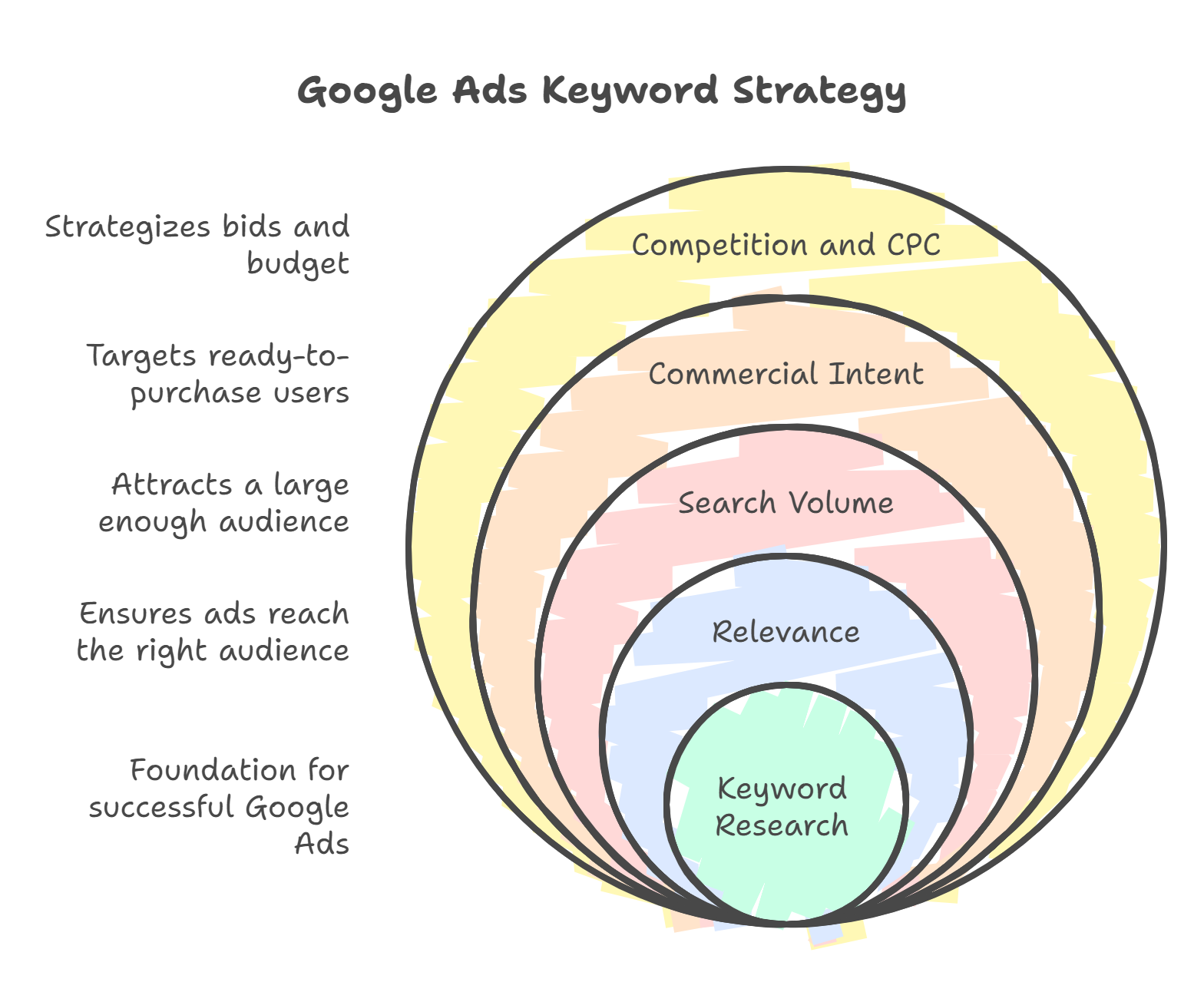About the Author
Alex is Founder & Strategic Advisor at UnitedAds, a leading digital marketing agency specializing in PPC Management.
With nearly two decades of industry experience, he has become a recognized authority in creating high-impact Google Ads campaigns that drive business growth.
Under his leadership, UnitedAds has built a strong reputation for delivering data-driven strategies that maximize ad performance and improve online visibility. Alex’s expertise lies in leveraging the full potential of PPC to help businesses scale efficiently and achieve sustainable success in the competitive digital marketing landscape.
The Google Keyword Planner (GKP) is the cornerstone of successful Google Ads campaigns. It’s not just a keyword suggestion tool; it’s a powerful research platform that provides insights into search volume, competition, cost estimates, and forecasting—all critical for crafting effective advertising strategies. Whether you’re a seasoned PPC expert or just starting with Google Ads, understanding how to use the GKP is essential for maximizing your ROI.
This guide will dive deep into the Google Keyword Planner, focusing on how to use its features to optimize your ad campaigns for improved targeting, lower costs, and higher conversion rates. You’ll learn how to discover the most relevant keywords, analyze their potential, and use them to build campaigns that drive real results.
The Core Concepts: Essential for Google Ads Success

Before we delve into the steps, it’s important to understand why keyword research is so crucial for Google Ads:
-
Relevance: Choosing the right keywords ensures that your ads are shown to users actively searching for products or services like yours. This is key to a high click-through rate (CTR).
-
Search Volume: Targeting keywords with sufficient search volume means your ads will be seen by a large enough audience to generate leads and sales.
-
Commercial Intent: Identifying keywords with strong commercial intent ensures that you’re targeting users ready to purchase, leading to better conversion rates.
-
Competition (for Ads): Understanding the competitive landscape lets you strategize your bids effectively and avoid wasting budget on overly saturated terms.
-
Cost Per Click (CPC): Keyword Planner allows you to estimate the CPC for each keyword, helping you manage your budget effectively.
-
Keyword Match Types: Utilizing the right match types (broad, phrase, exact) helps you control your ad spend and ensures you reach the right audience.
Step #1: Accessing the Google Keyword Planner – Your Gateway to Paid Success
The Google Keyword Planner is free to use, but it does require a Google Ads account. This is because the tool is designed primarily for Google Ads users.
-
Google Ads Account Requirement: You must have an active Google Ads account to access the GKP. You don’t necessarily need to be running a campaign to use the GKP, but having the account is essential.
-
Setting Up Your Account: If you don’t have one, it’s quick and easy. Go to ads.google.com and follow the prompts to create an account.
-
Finding the GKP: Once logged in, click on “Tools & Settings” then “Keyword Planner”. It’s often located in the “Planning” section.
You’ll then be presented with two options: “Discover New Keywords” and “Get search volume and forecasts.”
Step #2: Choosing the Right Tool for Your Advertising Goals
The Google Keyword Planner has two main tools; each one serves different purposes in your campaign development:
1. Discover New Keywords: Unveiling New Opportunities
-
Purpose: This tool is designed to find new keyword ideas based on inputs, helping you broaden your campaign reach and uncover hidden opportunities.
-
Two Input Methods:
-
“Start with keywords”: Enter words or phrases that describe your products or services. These are your seed keywords, and provide the foundation for the GKP.
* Strategic Input: Be thorough and consider all the ways customers search for your offering. If you sell “running shoes,” include keywords like “trail running shoes,” “best running shoes for women,” “marathon shoes” to get the widest range of ideas. Use commas to separate each keyword. -
“Start with a website”: Input a website (yours or a competitor’s) to discover keywords relevant to that site.
* Competitive Analysis: Use competitor’s websites to gain insights into their keywords, allowing you to discover unexploited opportunities.
-
-
How to use it:
-
Input Keywords or Website URL
-
Click “Get Results”
-
2. Get Search Volume and Forecasts: Analyzing Existing Lists
-
Purpose: This tool is ideal for validating the potential of existing keywords and forecasting the performance of your ads campaign.
-
Key Benefits:
-
Search Volume Accuracy: Validate the popularity of specific keywords and ensure that you’re not chasing low-volume terms.
-
Forecasting: Estimate clicks, impressions, and costs based on your target keywords, ensuring that you are able to manage your budget accordingly.
-
-
How to use it:
-
Enter/Paste a list of keywords
-
Click “Get Started”
-
The Keywords Results Page is where you’ll refine your results. Here’s how to use the filters and options to your advantage:
-
Top Page Options: Location, Language, Search Networks, Date Range
-
Location: Specify the countries/regions where you want to show your ads.
-
Language: Target users who speak a particular language.
-
Search Networks: Choose “Google” or “Google and Search Partners,” if your ad is suitable for other networks and you have the budget for it.
-
Date Range: Review keyword data over a specific period. Typically, “12 Months” is sufficient to understand long term trends, but shorter term views of seasonal keywords can be useful.
-
-
Filters:
-
Keyword Text: Include or exclude specific words or phrases to narrow down your focus.
-
Use Case: If you’re running an ad campaign for “discount coffee beans”, including the keyword “discount” will help you reach the right audience.
-
-
Exclude Keywords in My Account: Avoid overlapping with keywords you’re already using in other campaigns.
-
Exclude Adult Ideas: Ensure your brand isn’t associated with inappropriate content.
-
Avg. Monthly Searches: Filter by search volume. Higher search volume often translates to better reach, but also higher competition.
-
Competition (Ads-Focused): Filter based on the competition, to estimate how competitive certain keywords are for bidding.
-
Ad Impression Share: How often you’re showing your ads versus your competitors. Good for monitoring your performance compared to your competition.
-
Top of Page Bid (High & Low): The estimated cost to have your ad show at the top of the search results. Helps with campaign budgeting.
-
Organic Impression Share & Organic Average Position: Requires Google Search Console integration and will give an indication on where you rank organically for these keywords. This is not a filter directly useful for paid ads, but a good general indicator on how your brand performs on those keywords.
-
-
Keyword Match Types
-
Understanding these match types, Broad, Phrase and Exact, is crucial for how your ads match to search queries.
-
Step #4: Analyzing the Keyword Ideas Section: Key Metrics
Once you’ve applied your filters, it’s time to analyze the results:
-
Keyword (by relevance): Google’s evaluation of how relevant keywords are to your input.
-
Avg. Monthly Searches: The search volume provides a range rather than an exact number, use this as an estimate.
-
Seasonal Keywords: Be mindful of seasonal peaks and troughs that can skew the monthly average.
-
-
Competition (Ads): Use this to gauge competition among advertisers, which can greatly impact bid prices and ad visibility.
-
Top of Page Bid: A crucial metric for understanding the profitability of certain keywords and for budget planning.
Step #5: Keyword Selection Strategy for Google Ads
Choosing the right keywords involves balancing search volume, commercial intent, and budget:
-
High Search Volume Keywords: These can drive a lot of impressions, but often have high competition and require higher bids. Use match types and negative keywords to manage ad spend more effectively.
-
Commercial Intent Keywords: Keywords with high top of page bid values are often used by users close to a purchase decision. Focus on these keywords for higher ROI.
-
Long-Tail Keywords: Don’t underestimate long-tail keywords (e.g., “best lightweight trail running shoes for women”). These are often more specific and have lower competition, and can bring higher quality traffic.
-
Budget Management: Plan your bidding strategy according to your available budget, using keyword bids and budgets to control your spending.
Example Scenario:
Let’s say you’re running a campaign for “premium coffee beans”. You’d search for the term, filter by your target location and language, review the keywords by volume and commercial intent, and then analyze the suggested top-of-page bids. You might then choose a combination of high-volume, slightly more generic keywords (“coffee beans online”) alongside niche, high-intent long-tail keywords (“organic shade-grown fair-trade coffee beans”) to get a good mix of visibility and potential for conversion.
Bonus Step: Advanced Strategies and GKP Hacks
Here are some advanced strategies to maximize the GKP:
-
Competitor Keyword Research: Use the “Start with a website” feature to uncover keywords your competitors are bidding on. This allows for competitor analysis and targeting their keywords.
-
Negative Keywords: Use the GKP to identify negative keywords (words or phrases you don’t want your ads to show for). This will improve ad relevancy and reduce wasted spend.
-
Keyword Grouping: Group similar keywords into themes and create ad groups around those themes. This helps for targeted ads and bidding strategies.
-
Campaign Structure: Use the information gathered to build effective, tightly themed campaigns.
Conclusion: Your Path to Google Ads Success Starts with the GKP
The Google Keyword Planner is a core element of a successful Google Ads strategy.
By understanding how to leverage its features – the “Discover New Keywords” and the “Get Search Volume and Forecasts” features, utilizing the filters, carefully choosing keywords, and utilizing advanced strategies such as the competitor analysis feature, you can optimize your campaigns for improved targeting, lower costs, and higher conversion rates. The GKP empowers you to make data-driven decisions for maximum impact and ensure your ads are shown to the right audience at the right time. With the right plan and a smart approach using the GKP, your campaigns will achieve greater profitability and long-term success.







